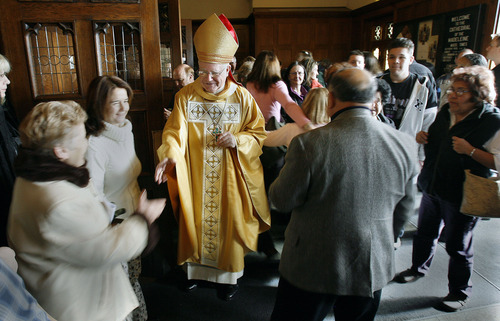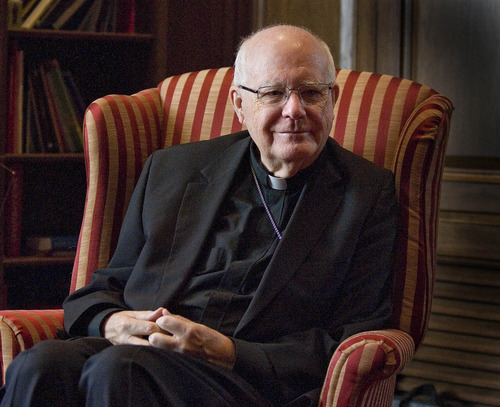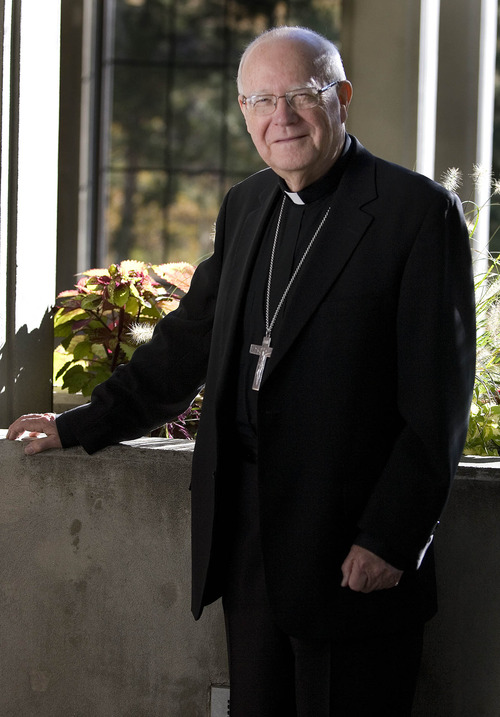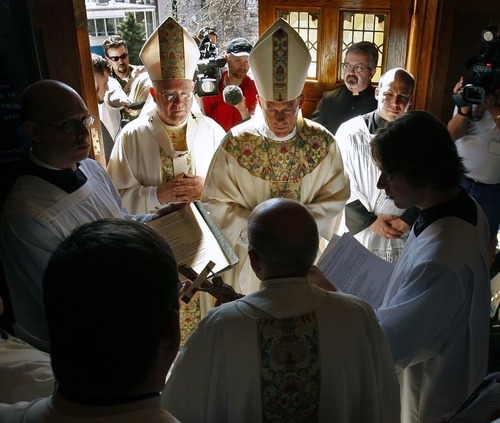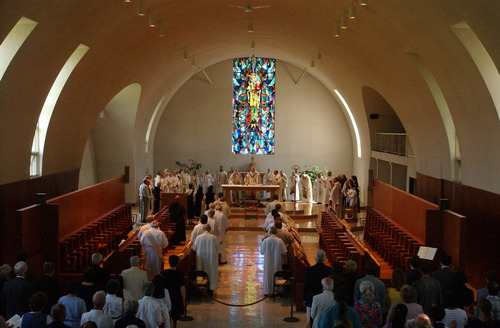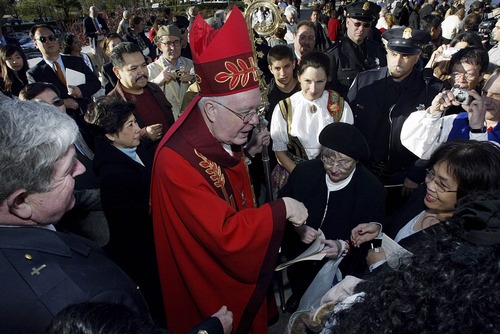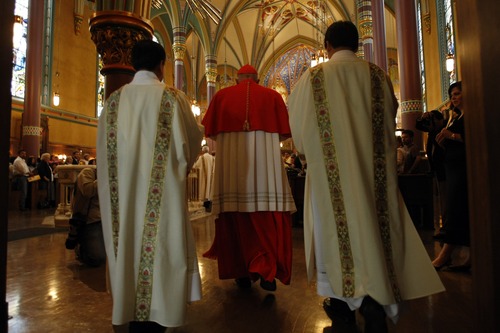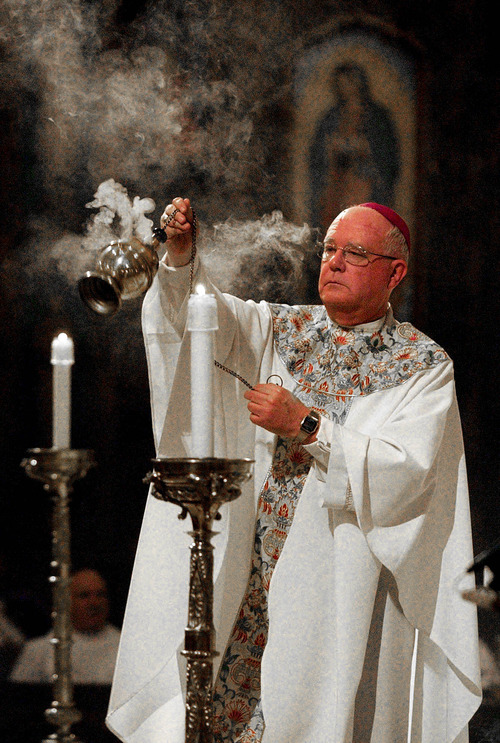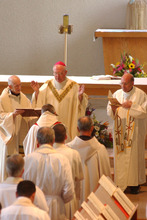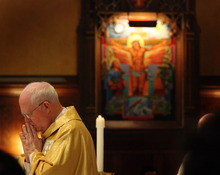This is an archived article that was published on sltrib.com in 2013, and information in the article may be outdated. It is provided only for personal research purposes and may not be reprinted.
Whether by accident, serendipity or divine design, four future heavyweights of American Catholicism found themselves in the Class of 1962 at St. John's Seminary on a lush hillside 60 miles from Los Angeles.
Momentous societal changes were surfacing all around the young men, but seminary life for George Niederauer — who served as Utah's bishop from 1995 to 2006 — and pals Roger Mahony, William Levada and Tod Brown continued much the same as it had since, oh, the 16th century. Part spiritual boot camp and part modern-day monastery, the school and its choreographed schedule stretched far beyond normal college rhythms — a Catholic "Goodbye, Mr. Chips."
The four friends — a pair of cardinals-to-be, a future archbishop and bishop — were assigned alphabetically to desks and dorms. They arose at 5:30 a.m. to the blareof an insistent hallway bell, and, within a half hour headed to the chapel for prayers and Mass. Silence was required during meals and after 7:30 p.m. Moral theology and philosophy classes were taught in Latin.
The priests-in-waiting had neither televisions nor telephones and were forbidden to leave the Camarillo, Calif., campus without permission. They could read about current events — such as the 1960 election of the first Catholic to the White House — but only in clips from approved newspapers.
They knew little of the simmering anti-authoritarian and anti-war sentiments percolating on college campuses, the rock music that would burst onto the scene with the Beatles or the looming sexual revolution.
Released from their Catholic cocoon in 1962, the young priests faced a church on the brink of volcanic reform with the opening of the Second Vatican Council, pushing the ancient institution into a new age. No more Latin Mass. Priests now faced the people, not the altar. Other Christians were embraced, and social work became gospel.
After being schooled in a Vatican I church, the foursome would step down, five decades later, as quintessential Vatican II men.
"There was no instruction manual with a chapter [to cover] every conceivable crisis for the next 50 years," says Mahony, who rose to archbishop of Los Angeles, his home turf and the nation's largest Catholic archdiocese.
And there were many unexpected twists — a precipitous decline in priests and nuns, growing divorce rates, the push for reproductive rights and gay rights, an increasingly ethnic population, widespread disaffection and school closings, and, of course, the priest sex-abuse scandal.
Niederauer, Mahony, Levada and Brown were gifted, dedicated men whose skills were recognized early and tapped often.
Levada ascended to archbishop of San Francisco and, later, the highest-ranking American in the Vatican. He and Mahony became cardinals, two of the "red hats" west of Chicago. Brown shepherded Idaho's diocese and then the Catholic flock in Orange, Calif., the fastest-growing diocese in the Golden State.
Niederauer, still beloved in Utah, was the last of the four to get a bishop's crosier and ring, overseeing the Salt Lake City diocese — Mahony ordained his friend and the other two assisted — before replacing Levada as archbishop of San Francisco.
All four Class of '62 alums retired within the past year or so, but they continue to meet regularly: once a year at Mahony's cabin in Fish Camp, just outside Yosemite National Park — though, Niederauer concedes, they neither fish nor camp — and again on the day after Christmas.
Here, then, is the story of the professor, the activist, the churchman and the ecumenist and the church they loved and helped lead.
A priest's priest • George H. Niederauer came of age after World War II during "an Indian summer of American Catholicism," says the Rev. Steven Avella, a history professor at Marquette University in Milwaukee.
The once-outsider church in Protestant America was now well-rootedon U.S. soil. In the East and Midwest, immigrants clustered in urban neighborhoods "etched with Catholic identity," Avella says, within walking distance of churches for worship and schools for inculcating their faith.
But in Southern California, where young George was reared as the only child of a businessman and homemaker, Catholics were vastly outnumbered among an increasingly diverse religious populace. Parishes stretched across miles of open geography, requiring a car to get to Mass.
Niederauer's parents drove him across town to Long Beach's all-male St. Anthony's Catholic High School, where he met Levada and where priests became the most potent forces in their lives. Teachers, mentors, confessors, counselors — these men of the cloth modeled a kind of life that left indelible imprints on the boys.
Slowly, almost inexorably, the four moved toward the priesthood. No flashes of lightning, no visions, no divine beckonings. Just a yearning to take their place alongside the men who had shaped them.
"They made the life of a priest attractive," Niederauer recalls. "They were happy, effective, smart and approachable. A young man could look at that and think, 'Well, that's a possibility.' "
One by one, three boys opted for St. John's after graduating from high school, but Niederauer had developed a separate passion — English literature.
The future professor enrolled at Stanford, delighting his parents. During Christmas break, however, he got together with his pals and, he says, "they were doing what I wanted to do." So Niederauer transferred to the seminary, where he could become a priest and still write and produce witty skits and plays for students and faculty.
Niederauer was ordained May 1, 1962 — a day after Mahony — then worked in a parish for a few years, while pursuing graduate work in literature. By 1966, he had earned a doctorate from University of Southern California, writing his dissertation on an 18th-century British satire called "A School for Scandal."
A year later, Niederauer returned to teach literature and moral philosophy at St. John's and stayed another 27 years, eventually becoming seminary rector — like a president — and wrestling with how best totrain the new generation of priests.
Gregorian chants gave way to contemporary and non-Catholic hymns, while guitars became popular Mass instruments, says Monsignor Peter Nugent, a St. John's music teacher and classmate of Niederauer. Silent periods were phased out, more classes and books were in English, and seminarians routinely left campus for parish and charity work.
There was more "acceptance of [priests'] humanity," says University of Utah historian Colleen McDannell. "They went to the movies, traveled, vacationed with friends and family. The distance between priest and laity diminished."
In Salt Lake City and again in San Francisco, Niederauer built morale among his priests by creatively matching talents with assignments, says Monsignor Terrence Fitzgerald, who served as his vicar general in Utah. The bishop's "collaborative style of leadership" made him popular everywhere he went.
Though Niederauer defended his church's anti-gay marriage stance and even enlisted LDS Church President Thomas S. Monson to help pass California's Proposition 8, defining marriage as only between a husband and wife, the bishop hadn't supported a similar Utah amendment.He pushed back when the Vatican tried to bar homosexuals from the seminary, allowed a short-lived Mass for gaysand was the nation's first Catholic bishop to praise the gay love story, "Brokeback Mountain."
Priests were the brothers he never had.
The workers' ally • After Vatican II, the church transformed its approach to poverty, says McDannell, author of The Spirit of Vatican II: A History of Catholic Reform in America.It moved beyond feeding people to attacking the systemic and societal causes of hunger.
That direction fit Mahony's instincts.
As a child, young Roger was traumatized by the sight of border patrol agents crashing through the doors of his father's small poultry-processing plant in North Hollywood. Guns drawn, they were looking for illegal immigrants among the plant's handful of Mexican-born employees.
"Turned out everybody had documentation," Mahony says, "but the assumption that, because they were Latino there must be something wrong with them, struck me deeply."
Mahony, a talkative, animated student, learned Spanish while still in high school and, during his seminary years, spent many Sundays in the fertile California fields helping a priest celebrate Mass and hear confessions from Mexican migrant workers.
It was the height of the bracero movement, which allowed foreigners to take temporary agricultural work in the United States. During this time, Mahony joined labor icon Cesar Chavez, who wielded protests, strikes and boycotts to draw attention to worker safety and wage issues.
While ministering to the workers, Nugent and Mahony formed a band to play Mexican pop songs. The future cardinal "couldn't sing a note; he was tone deaf," Nugent says. "But he could he play the guitar."
And Mahony loved tinkering with electronics of any kind. He did lighting and sound for Niederauer's plays and eagerly awaited each new technological advance.
After his 1962 ordination, Mahony earned a master's degree in social work from Catholic University in Washington, D.C., focusing on community organizing. When he returned to the West, he was on a hierarchical fast track. He became the church's lobbyist in Sacramento, where he helped broker a settlement between farmworkers and growers, and then headed Catholic Charities of California. He was named auxiliary bishop of Fresno in 1975 at age 38. Five years later, he was elevated to bishop over Stockton. In 1985, he stepped up as archbishop of L.A.
The City of Angels was a sprawling diocese of more than 1 million Catholics, so Mahony engaged his old pal Levada to help manage the shifting demographics. The two divided the area into five pastoral regions, with an auxiliary bishop for each.
Mahony then set about pushing the church physically and spiritually into the 20th century.
He surveyed the population, asking about their priorities. He organized and computerized church finances. When there were not enough priests, he recruited laity to shoulder the workload, which triggered some resistance from conservative Catholics. He closed down a historic cathedral over the objections of preservationists and old-school Catholics and built a modernist — and expensive — replacement, the Cathedral of Our Lady of the Angels, built near, of course, a freeway.
The one-time audio/visual geek tangled with Catholic media star Mother Angelica, a right-leaning nun who criticized Mahony on her cable TV show. By then a cardinal, he demanded an apology. Eventually, she apologized.
Mahony was "a deft practitioner of ecclesiastical politics," Avella says. "He was personable and likable and could read the changing times."
That wasn't too hard — he had friends in the Vatican.
A Roman soldier • By all accounts, William Levada was the most intense and serious of the St. John's quartet — which made him a prime target for pranks. One night, Niederauer, Brown and Mahony (who had the idea) put a camera flashbulb in Levada's overhead light and a dead chicken hawk in the closet just to see his startled reaction.
What didn't surprise them, though, was Levada's decision to spend his final undergraduate years studying theology at the Pontifical North American College and Pontifical Gregorian University.
"Rome is the center of Catholicism and has been for 2,000 years," Levada says. "Just being there was an education."
From then on, the Vatican became the focus of his vision and ministry, eventually bringing him into the presence of Popes John Paul II and Benedict XVI. He returned again and again from California to the Eternal City to study — earning a doctorate with a dissertation on infallibility — and to work in the Vatican bureaucracy.
Always a careful, evenhandedwriter, Levada was the only American on the Vatican's 1986 bishops' commission to redo the catechism, which spells out Catholic teachings.
After serving for nine years in the Northwest as Portland's archbishop, Levada returned to California to replace the liberal Archbishop John Quinn of San Francisco.
Bay Area Catholics braced themselves for a conservative crackdown, but the self-effacing Levada put them at ease, quipping that he "left my Darth Vader costume at home." As a moderate pragmatist, Levada defended church doctrines and decisions, yet refused to attack opponents.
When changing demographics and finances forced the diocese to shut down 14 churches, Levada found ways to appease angry parishioners by turning some into shrines or community centers. When other bishops showed their disapproval of pro-choice politicians by withholding Communion, Levada preferred to engage with them instead.
In 2005, Benedict named Levada as his successor as head of the Congregation for the Doctrine of the Faith, a powerful panel overseeing theological disputes as well as abuse cases. Rather than being "God's Rottweiler," as some had dubbed Benedict, Levada joked that he would be, according to theNational Catholic Reporter'sJohn Allen, more like God's "cocker spaniel."
Levada shuns the limelight — donning shorts and a floppy hat on weekends to tour Rome's treasured churches and museums undetected — and is no ideologue. Sure, he signed off on recent criticism of progressive American nuns and was stern and unbending toward abusive priests, Allen writes, but admirers say the Vatican insider has "genuine empathy and a desire to find ways to keep [sides] talking despite differences."
Fellow traveler • Tod Brown grew up in Northern California and met the others for the first time at St. John's.
Like Levada, he spent his last seminary years at the church's American universities in Rome. But he fell ill and returned to St. John's to be ordained in May 1963, a year later than his friends.
After ordination, Brown served in various California parishes. In 1989, he became bishop — consecrated by Levada — of Boise, a place he had never visited and knew little about. The Catholics there were dwarfed in number by the predominant Mormons.
A decade later, he returned to California, taking the helm of Orange, a large community that included Latino, Vietnamese and Filipino immigrants.
Brown was named to the pope's council on ecumenism and interreligious affairs and explored relationships with faiths such as Islam as well as other Christians.
Before the Sept. 11 terrorist attacks, relations between his Catholic priests and Muslims were "cool," but afterward,they warmed up dramatically, Brown says. "We've come to appreciate each other."
In one of his last acts before retiring earlier this month, Brown authorized the purchase of the all-glass Crystal Cathedral, built for the Rev. Robert Schuller's "Tower of Power" broadcasts. Brown had been looking to build a cathedral for the diocese, which didn't have one, but got Schuller's iconic tower and surrounding campus for much less. It can become the center of Orange's Catholic community and, Brown hopes, a lasting symbol of his interfaith involvement.
For Brown and his friends, though, the priest abuse crisis would cast a long shadow on their accomplishments.
A cancer exposed • Most American Catholic bishops first handled abusive priests the way they had long treated alcoholic clerics — send the offender off to a retreat center to dry out, then bring him back to serve again. They relied on psychiatrists, they say, who promised them that these men were "cured" and safe for the ministry.
Reportedly, St. John's Seminary, where these four men trained, had an even higher incidence of abuse than in the rest of the country. But, they say, they knew nothing of it.
The priests may have been their family, says the Rev. Thomas Reese, a Georgetown scholar, "but the thing all the bishops forgot was that the kids were also their family."
The four acknowledge their failure to grasp the depth, breadth and insolubility of the problem. Niederauer was a member of the 2002 bishops' Ad Hoc Committee on Sexual Abuse, assigned to create policies for protecting children in the future, while Mahony, Brown and Levada were on the hot seat as they faced hundreds of cases and victims in L.A., Orange and San Francisco. Eventually, the latter three would spend daystestifying in court, fighting the push to open the church's personnel files. All three oversaw payments of millions to victims.
Victim advocate David Clohessy remains skeptical of the bishops' sincerity.
"Panels, policies and procedures do not make a difference, only radical change in their own behavior will," says Clohessy, director of SNAP (Survivors Network of those Abused by Priests) and a victim himself. "The crux of the crisis is the limitless power of bishops."
Mahony, for one, sometimes felt downright powerless.
"Even during the middle of the night," Mahony recalls, "I would get up and go to chapel and say, 'Lord, I don't have any answers. You've got to help us.' "
Those sleepless nights might not be over. He and his friends may wind up back in court on abuse cases.
End of an era • Many all-male Catholic high schools are gone now and lay men and women have taken over the role of priests at coed parochial schools. The country's priest candidates are older and often foreign-born. More moderate Vatican II-esque leaders have been replaced by doctrinal conservatives, and priests do not run parishes alone as they once did.
That's OK with Mahony.
"I don't want to go back," says the cardinal, who has taken up residence in the little house behind St. Charles Borromeo Church, his childhood parish in North Hollywood. "In God's providence, we will have enough priests ... [and will develop] new forms of ministry that make the church more vital."
The four old friends, all age 76, plan to travel, write, assist in parishes and work on pet projects.
Mahony continues to blog, preach and push for immigration reform. Brown has settled into his predecessor's house in Orange, where he will maintain his ecumenical outreach.
Niederauer and Levada are sharing a condo in Long Beach, the town of their youth. Niederauer also has a house on the campus of St. Patrick's Seminary & University in Menlo Park, where Levada will spend some of his time.
Mutual affection runs deep.
"Grow old along with me," Levada said, quoting the poet Robert Browning at Niederauer's golden anniversary of his ordination last spring. "The best is yet to be, the last of life, for which the first was made."


